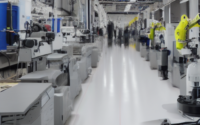AR advances transforming industrial manufacturing
AR advances transforming industrial manufacturing
Introduction to Augmented Reality in Manufacturing:
Augmented Reality (AR) technology has been making significant strides in revolutionizing the manufacturing industry. By overlaying digital information onto the physical world, AR enhances productivity, efficiency, and safety in various manufacturing processes. In this article, we will explore the latest AR advances that are transforming industrial manufacturing.
Enhanced Training and Onboarding Processes:
One of the key areas where AR is making a significant impact in industrial manufacturing is in training and onboarding processes. Traditional training methods can be time-consuming and costly, involving physical prototypes and dedicated training sessions. With AR, new employees can undergo immersive training experiences using digital overlays, interactive instructions, and simulations. This not only reduces training time but also enhances knowledge retention and ensures consistent quality across the workforce.
Maintenance and Repairs with AR:
AR is also streamlining maintenance and repair tasks in industrial settings. By using AR-enabled smart glasses or mobile devices, technicians can access real-time information, schematics, and step-by-step guides overlaid onto the machinery or equipment they are working on. This hands-free approach allows technicians to troubleshoot issues more efficiently, leading to shorter downtimes and increased operational uptime. AR also facilitates remote assistance, where experts can guide on-site technicians through complex repairs from anywhere in the world.
Design and Prototyping Advancements:
In the realm of design and prototyping, AR is enabling engineers and designers to visualize and interact with 3D models in a real-world context. By superimposing virtual designs onto physical environments, AR helps in assessing the form, fit, and function of new products before they are physically built. This iterative process allows for rapid prototyping, design validation, and collaboration among cross-functional teams, ultimately accelerating the product development cycle.
Quality Control and Inspection Applications:
AR technologies are increasingly being utilized for quality control and inspection tasks in manufacturing facilities. Through AR-powered devices, inspectors can compare digital models or CAD drawings with physical components in real-time, identifying any deviations or defects quickly and accurately. This visual guidance enhances the inspection process, reduces human error, and ensures that products meet stringent quality standards before they reach the market.
Supply Chain Management Optimization:
AR is playing a vital role in optimizing supply chain management processes within the manufacturing sector. By integrating AR systems into warehouse operations, inventory management, and logistics, companies can gain real-time insights into their supply chain activities. AR-powered tools enable warehouse personnel to locate and pick items accurately, track shipments efficiently, and visualize inventory levels, leading to improved operational efficiency and reduced costs.
Safety and Risk Mitigation Measures:
Safety is paramount in industrial manufacturing, and AR is helping in enhancing workplace safety and risk mitigation measures. AR-equipped safety helmets or glasses can provide workers with real-time safety alerts, hazard warnings, and ergonomics guidance as they perform their tasks. By augmenting the physical environment with digital safety information, AR helps in reducing accidents, improving worker well-being, and ensuring compliance with safety regulations.
Future Outlook and Challenges:
As AR continues to advance, its applications in industrial manufacturing are poised to expand further. The integration of technologies like machine learning, IoT, and cloud computing with AR promises to unlock new possibilities for smart factories and connected industrial systems. However, challenges such as data security, interoperability, and workforce readiness remain to be addressed to realize the full potential of AR in manufacturing. Companies that invest in AR solutions and prioritize employee training and upskilling in AR technologies will be better positioned to reap the benefits of this transformative technology.

